| کد مقاله | کد نشریه | سال انتشار | مقاله انگلیسی | نسخه تمام متن |
|---|---|---|---|---|
| 5532861 | 1549994 | 2016 | 9 صفحه PDF | دانلود رایگان |

- LaeA mutants of the pine pathogen Dothistroma septosporum were produced.
- LaeA negatively regulates production of the virulence factor dothistromin.
- Expression of the dothistromin pathway regulator AflR was increased in LaeA mutants.
- LaeA mutants showed high levels of an unknown metabolite not seen in the wild type.
- Incomplete complementation by Cladosporium fulvum LaeA suggests species specificity.
In filamentous fungi both pathway-specific and global regulators regulate genes involved in the biosynthesis of secondary metabolites. LaeA is a global regulator that was named for its mutant phenotype, loss of aflR expression, due to its effect on the aflatoxin-pathway regulator AflR in Aspergillus spp. The pine needle pathogen Dothistroma septosporum produces a polyketide virulence factor, dothistromin, that is chemically related to aflatoxin and whose pathway genes are also regulated by an ortholog of AflR. However, dothistromin biosynthesis is distinctive because it is switched on during early (rather than late) exponential growth phase and the genes are dispersed in six loci across one chromosome instead of being clustered. It was therefore of interest to determine whether the function of the global regulator LaeA is conserved in D. septosporum. To address this question, a LaeA ortholog (DsLaeA) was identified and its function analyzed in D. septosporum. In contrast to aflatoxin production in Aspergillus spp., deletion of DsLaeA resulted in enhanced dothistromin production and increased expression of the pathway regulatory gene DsAflR. Although expression of other putative secondary metabolite genes in D. septosporum showed a range of different responses to loss of DsLaeA function, thin layer chromatography revealed increased levels of a previously unknown metabolite in DsLaeA mutants. In addition, these mutants exhibited reduced asexual sporulation, germination and hydrophobicity. Our data suggest that although the developmental regulatory role of DsLaeA is conserved, its role in the regulation of secondary metabolism differs from that of LaeA in A. nidulans and appears to be species specific. This study provides a step towards understanding fundamental differences in regulation of clustered and fragmented groups of secondary metabolite genes that may shed light on understanding functional adaptation in secondary metabolism.
Journal: Fungal Genetics and Biology - Volume 97, December 2016, Pages 24-32